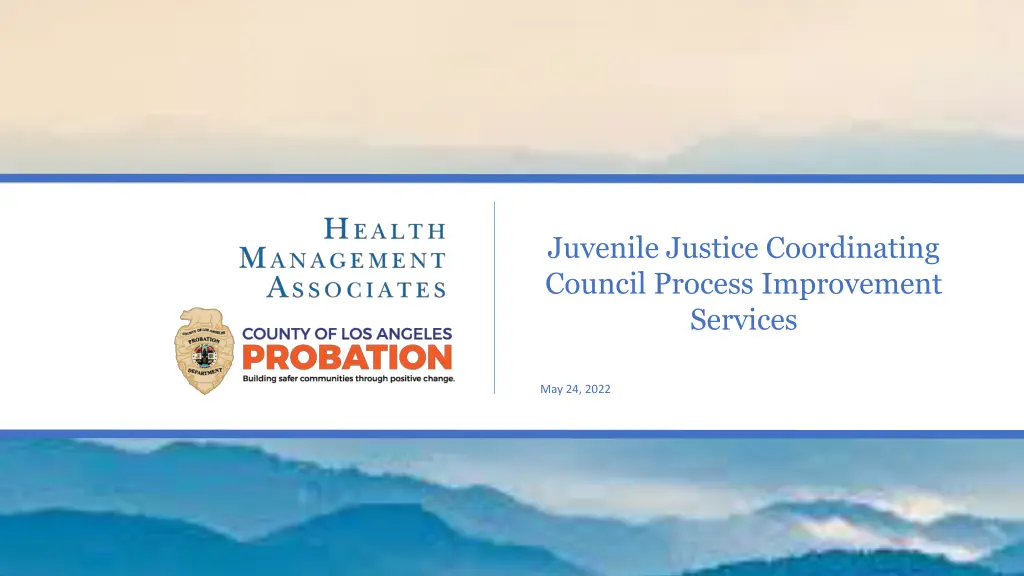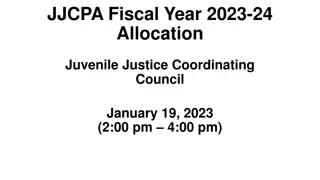
Juvenile Justice Council Process Improvement and Community Engagement
Explore the progress and challenges faced by the Juvenile Justice Coordinating Council in their process improvement efforts. Discover insights from key informant interviews, meetings, and community engagement activities. Identify areas for enhancement and steps towards effective planning and funding allocations in juvenile justice programs.
Download Presentation

Please find below an Image/Link to download the presentation.
The content on the website is provided AS IS for your information and personal use only. It may not be sold, licensed, or shared on other websites without obtaining consent from the author. If you encounter any issues during the download, it is possible that the publisher has removed the file from their server.
You are allowed to download the files provided on this website for personal or commercial use, subject to the condition that they are used lawfully. All files are the property of their respective owners.
The content on the website is provided AS IS for your information and personal use only. It may not be sold, licensed, or shared on other websites without obtaining consent from the author.
E N D
Presentation Transcript
Juvenile Justice Coordinating Council Process Improvement Services May 24, 2022 1
AGENDA REVIEW OF PROCESS IMPROVEMENT EVENT DISCUSSION OF AREAS OF FOCUS NEXT STEPS QUESTIONS 2
HMA completed the first three stages of the workplan by the end of May. Process Improvement Meeting Survey and key informant interviews were completed. A Process Improvement meeting was conducted on July 26. The meeting included most of the Governance and Procedure Ad Hoc Subcommittee (one member was unavailable), and the HMA team.
HMA collaborated with the Governance Subcommittee on the agenda, and selected a mapping exercise to evaluate steps toward development of the plan and funding allocations. Prior to the process improvement meeting The goal of the mapping exercise was to go through each step and review: What was working well What was not working well What are potential improvements During the mapping exercise, several concerns surfaced regarding the process involving the development of the CMJJP
Identification of populations of focus are well thought out and based on meaningful data about the population of focus. This data is presented in the yearly CMJJP. There is a strong commitment to getting wide community input from the Community Advisory Council. What is going well? The scoring process has been revised several times, and the group has developed a strategy for scoring where there is consensus on scoring, and meaningful discussion on the funding priorities. There is consensus on the time needed for the CMJJP to score and get input from the JJCC.
Overall, there is a sense that there is not enough time to complete the process in the time allotted. What steps in the process can be improved? The group explored whether there were steps in the process that were unnecessary and/or inefficient. For example, there was discussion on the utility of survey. The survey takes many hours of work. However, there has not been a way to meaningfully incorporate survey results into funding allocations decisions. The Urban Peace Institute had led the development of the survey, but discussion surrounded whether survey needs to be retooled to make it more impactful on the overall plan development.
Each year, programs are provided an opportunity to fill out information on their services, and this is presented to the committee. However, this is also not well integrated into funding decisions. Program information gathering Since funding goes to government agencies rather than community-based organizations, there is a question about why this information is being gathered. This practice has potential to create distrust and misunderstanding between government agencies and community based organizations. This is an area of potential improvement.
There are a number of programs that get funding yearly Funding allocation process However, each organization has to apply each year for funding. This requires the applications to be completed repeatedly, and also requires the agencies granting funds to have a yearly solicitation process. A discussion of the possibility of multiyear funding cycles, at least for some of the funding, was introduced.
The Probation Department has had oversight of the development of the CMJJP process since it started in 2001. However, the percentage of funding that goes to Probation has gone down over the years. Operational organization of the JJCC Probation continues to take responsibility for the organization of the JJCC and the process of overseeing the coordination of the JJCC. While WIC 749.22 designates the Chief Probation Officer as the chair of this committee and to ensure compliance with the law, other counties have implemented models in which the operational tasks of the committee is contracted out.
While the process improvement meeting allowed the Governance Council to evaluate potential improvements, this meeting was a starting point. Future meetings are needed to decide on priorities and potential action steps. Next Steps These will be brought back to the JJCC for discussion and decision making. Additional areas of interest that were noted but not thoroughly discussed include: Initial and ongoing training for JJCC members. The structure of the Community Advisory Committee to increase community feedback.

